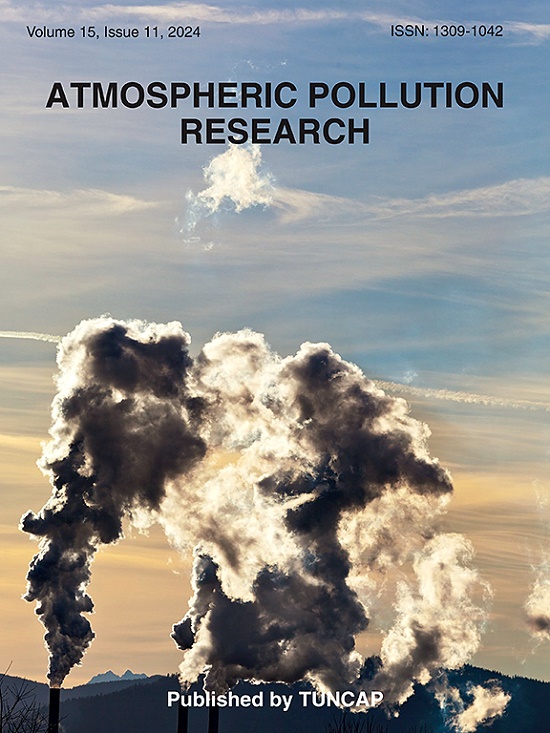复杂地形中与多个烧伤单位相关的颗粒浓度:数值研究
IF 3.5
3区 环境科学与生态学
Q2 ENVIRONMENTAL SCIENCES
引用次数: 0
摘要
低强度规定火灾产生的烟雾危害到地面消防人员和附近社区的健康和安全,主要是通过空气质量受损和能见度降低来实现的。准确预测烟雾扩散对于防止意外的、潜在危险的烟雾侵入人口稠密地区至关重要。这项工作解决了限制烟雾预测准确性的三个具体知识空白:(i)复杂地形对烟雾行为的影响,(ii)多个活跃燃烧单元的影响,以及(iii)浮力羽流上升的作用。采用先前验证的拉格朗日粒子弥散模型来模拟宾夕法尼亚州东部山脊线河流缝隙内和周围的粒子弥散。在一系列理想化的模拟中,粒子在5个1公里× 1公里的释放区中释放,有15种释放区和释放深度的组合(选择这些组合是为了粗略地表示假设的强度不断增加的火灾对浮力羽流上升和羽流高度的影响)。结果表明,河口下风颗粒物浓度大小和分布与释放带的数量和位置呈非线性关系。此外,单个源对下游浓度的相对贡献可能会有所不同,这取决于浮力羽流上升是否足够大,足以在整个混合层或混合层上方分布颗粒,或者仅在近地表分布颗粒,可以忽略不计。总体而言,研究结果表明,下游烟雾浓度大小和分布与源的空间排列和羽流特征有关,强调了在烟雾管理策略中考虑这些因素的必要性。本文章由计算机程序翻译,如有差异,请以英文原文为准。
Particulate concentration associated with multiple burn units in complex terrain: A numerical study
Smoke from low-intensity prescribed fires jeopardizes the health and safety of both on-the-ground fire personnel and nearby communities, mainly through compromised air quality and reduced visibility. Accurate prediction of smoke dispersion is crucial to prevent unintended, potentially hazardous smoke intrusions into populated areas. This work addresses three specific knowledge gaps that limit smoke prediction accuracy: (i) the influence of complex terrain on smoke behavior, (ii) the effects of multiple active burn units, and (iii) the role of buoyant plume rise. A previously-validated Lagrangian particle dispersion model is employed to simulate particle dispersion in and around a river gap through an eastern Pennsylvania ridgeline. A series of idealized simulations is conducted in which particles are released within five 1-km x 1-km release zones, with fifteen combinations of release zones and release depths (chosen to roughly represent the impact of hypothetical fires of increasing intensity on buoyant plume rise and plume height). Results show that particle concentration magnitude and distribution downwind of the river gap are nonlinearly related to the number and location of release zones. Furthermore, the relative contribution from an individual source to downstream concentration may vary depending on whether buoyant plume rise is substantial enough to distribute particles throughout or above the mixed layer or is negligible with only near-surface distribution of particles. Overall, the results suggest that downstream smoke concentration magnitude and distribution are linked to both the spatial arrangement of sources and the plume characteristics, highlighting the need for consideration of these factors in smoke management strategies.
求助全文
通过发布文献求助,成功后即可免费获取论文全文。
去求助
来源期刊

Atmospheric Pollution Research
ENVIRONMENTAL SCIENCES-
CiteScore
8.30
自引率
6.70%
发文量
256
审稿时长
36 days
期刊介绍:
Atmospheric Pollution Research (APR) is an international journal designed for the publication of articles on air pollution. Papers should present novel experimental results, theory and modeling of air pollution on local, regional, or global scales. Areas covered are research on inorganic, organic, and persistent organic air pollutants, air quality monitoring, air quality management, atmospheric dispersion and transport, air-surface (soil, water, and vegetation) exchange of pollutants, dry and wet deposition, indoor air quality, exposure assessment, health effects, satellite measurements, natural emissions, atmospheric chemistry, greenhouse gases, and effects on climate change.
 求助内容:
求助内容: 应助结果提醒方式:
应助结果提醒方式:


